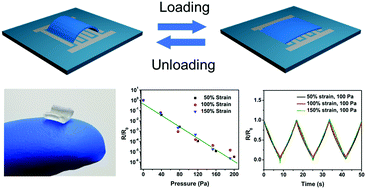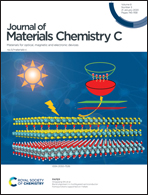A multidimensional hierarchical structure designed for lateral strain-isolated ultrasensitive pressure sensing†
Abstract
Most of the as-reported piezoresistive sensors are difficult to use under dynamic deformation (e.g., bending, twisting, and buckling) since their pressure sensitivities vary significantly as a result of the lateral strain induced by dynamic deformation. Herein, taking advantage of the “modulus mismatch” and “Poisson effect”, a brand new multidimensional hierarchical structure (i.e., a wrinkle structure arranged in the pre-stretching direction and arch structure perpendicular to the pre-stretching direction) is designed and introduced in strain-isolated ultrasensitive piezoresistive sensing. The obtained pressure sensitivity is as high as 4.54 kPa−1 under small pressures (0–200 Pa) and remains constant under variable lateral strains (0–150%). The aim of this novel structure is to realize accurate pressure measurements under dynamic deformation and superior properties in conjunction with a low detection limit, fast response, and high stability, making our piezoresistive sensors promising in various practical and clinical applications, such as real-time health monitoring and wearable sensing devices.



 Please wait while we load your content...
Please wait while we load your content...